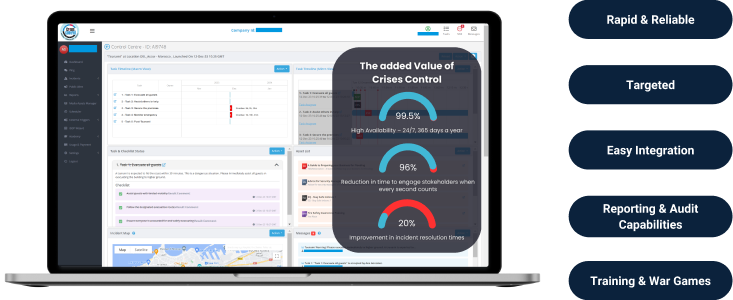Written by Anneri Fourie | Marketing Executive
The aviation industry thrives on efficiency and precision. Yet, even the most meticulously planned flights can be thrown into disarray by unforeseen circumstances. From bad weather to mechanical issues, public health crises to data breaches, airlines face a multitude of challenges that can disrupt operations, damage reputations, and leave passengers stranded and frustrated.
In today’s hyper-connected world, effective crisis communication is no longer a luxury, it’s a necessity. Passengers expect real-time updates, clear instructions, and a sense of control during disruptions. Airlines, on the other hand, need a reliable system, like Crises Control’s mass notification software, to reach a vast audience quickly, deliver consistent messaging, and maintain operational continuity.
Types of Crises Airlines May Face
Airlines are susceptible to a wide range of crises, both internal and external. Here’s a closer look at some of the most common ones:
- Operational Disruptions: These can be caused by bad weather, technical issues with aircraft, air traffic control delays, or even runway closures. In 2022, a major winter storm caused widespread cancellations and delays across the United States, leaving thousands of passengers stranded.
- Safety Incidents: While rare, airline accidents and security breaches can have a devastating impact on an airline’s reputation and passenger confidence. The 2021 Boeing 737 MAX grounding, due to safety concerns, is a stark reminder of the potential consequences.
- Medical Emergencies: Onboard medical emergencies require a swift and coordinated response from crew members. Effective communication with medical personnel on the ground is crucial.
- Public Health Crises: Pandemics like COVID-19 significantly disrupt air travel and require airlines to adapt quickly to changing health regulations and passenger concerns.
- Data Breaches: Cybersecurity threats are a growing concern for airlines, with passenger data breaches potentially leading to significant financial losses and reputational damage.
- Labour Disputes: Disagreements between airlines and unions representing pilots, flight attendants, or ground staff can lead to strikes and work stoppages, causing major travel disruptions.
The impact of these crises can be far-reaching:
- Reputation Damage: Negative media coverage and dissatisfied passengers can severely tarnish an airline’s brand image.
- Operational Hinders: Disruptions can lead to flight cancellations, delays, and increased operational costs.
- Staff Stress: Crisis situations can put immense pressure on airline personnel, leading to burnout and decreased morale.
- Passenger Anxiety: Uncertainty and lack of information can heighten passenger anxiety during a crisis, potentially impacting future travel decisions.
The Power of Mass Notification Software: Communicating Effectively in Times of Crisis

In the midst of a crisis, timely and accurate communication is paramount. This is where mass notification software becomes an invaluable tool. It allows airlines to:
- Reach a Large Audience Quickly: With a few clicks, airlines can send critical updates to passengers, staff, and stakeholders across various channels – SMS, email, push notifications, voice calls, and even social media platforms.
- Deliver Targeted Messages: Segmentation allows airlines to tailor messages to specific groups, such as passengers on affected flights, crew members on duty, or loyalty program members.
- Ensure Consistent Messaging: Mass notification software helps maintain a unified brand voice and ensures everyone receives the same accurate information.
- Track Delivery and Engagement: Real-time analytics provide valuable insights into how effectively messages are being received and understood.
- Facilitate Two-Way Communication: Some platforms allow for two-way communication, enabling airlines to gather feedback from passengers and address concerns directly.
Here’s real-world examples of how mass notification software can be used effectively:
Dubai Floods
In April 2024, torrential rain caused severe flooding in Dubai, impacting infrastructure and transportation. Airlines faced the challenge of informing passengers about potential flight cancellations, delays due to airspace restrictions, and revised schedules.
An airline equipped with mass notification software could have:
- Proactively Informed Passengers: Alerts could be sent via SMS, email, and the airline app, informing passengers about the situation and potential flight disruptions well in advance.
- Provided Clear Rerouting Options: Passengers could be notified of alternative flight options or rebooking procedures through self-service channels within the notification.
- Mitigated Passenger Anxiety: Real-time updates on the situation and estimated recovery times would keep passengers informed and reduce anxiety during a stressful time.
By leveraging mass notification software, the airline could have maintained clear communication with passengers throughout the crisis, minimising confusion and frustration.
Icelandic Volcano Eruption
In March 2024, a volcanic eruption in Iceland threatened to disrupt air travel across Europe. Airlines faced the challenge of informing passengers about potential airspace closures, flight cancellations, and rebooking options.
Mass notification software could have proven invaluable in this situation:
- Targeted Communication: Alerts could be sent to passengers booked on flights to or from Europe, informing them about the potential impact of the eruption.
- Multi-Channel Delivery: Reaching passengers through their preferred channels (SMS, email, app notifications) ensures critical information is received.
- 2-Way Communication: Airlines could gather information from passengers about their preferences for rebooking or cancellations, allowing for a more streamlined response.
This proactive communication would have empowered passengers to make informed decisions and minimise disruptions to their travel plans.
These recent events highlight the critical role mass notification software plays in crisis communication for airlines. By ensuring timely, clear, and targeted communication during disruptions, airlines can not only manage passenger expectations, but also maintain trust and reputation during challenging situations.
Crises Control: Your Partner in Crisis Preparedness and Response
While Crises Control doesn’t directly communicate with passengers, we empower airlines to do so effectively. Our comprehensive mass notification solution, designed specifically for the airline industry, equips airlines with the tools to:
- Craft Streamlined Communication Plans: Develop pre-defined templates and protocols for various crisis scenarios. This ensures a swift and coordinated response from your staff, allowing them to deliver clear and consistent messaging to passengers through your preferred channels.
- Navigate Crisis Situations with Real-Time Visibility: Our platform offers a centralised command centre for real-time incident management. Track the progress of a crisis, assign tasks to specific staff members, and monitor response efforts – all in one place. This allows for a coordinated and efficient response, minimising confusion and expediting resolution.
- Empower Staff to Mitigate Passenger Anxiety: Crises Control empowers your staff to effectively manage passenger concerns through clear and consistent communication updates. Our multi-channel delivery system ensures information reaches passengers quickly and efficiently, minimising anxiety during a stressful event.
- Maintain Operational Continuity Through Seamless Staff Communication: During a crisis, clear communication among your staff is crucial for maintaining business continuity. Our platform facilitates efficient information flow within your organisation, ensuring all departments are informed and can contribute to a swift resolution.
By investing in Crises Control, airlines can equip their staff with the tools they need to effectively communicate during any crisis. This fosters trust and transparency with passengers, minimises disruptions, and safeguards your airline’s reputation.
Conclusion
In this blog, we’ve explored the power of Mass Notification Software and how it can revolutionise your organisation’s communication strategy. We discussed the various functionalities of these systems, from delivering time-sensitive alerts during emergencies to streamlining day-to-day communication. Highlighted throughout were the key benefits of Mass Notification Software, including improved safety and security, increased operational efficiency, and enhanced employee satisfaction.
The importance of Mass Notification Software cannot be overstated. In today’s fast-paced world, the ability to send critical information quickly and efficiently is essential. This software ensures that everyone in your organisation, from staff and students to visitors and guests, receives the messages they need, when they need them most.
Ready to experience the transformative power of Mass Notification Software for yourself? Contact Crises Control today and speak with a friendly expert. We’ll help you assess your organisation’s needs and find the perfect solution to keep everyone informed and safe. Don’t wait until an emergency strikes – take control of your communication today.
Request a FREE Demo
Interested in our Mass Notification Software?
FAQs
1. What is Mass Notification Software?
Mass Notification Software allows organisations to send critical information to large groups of people quickly and efficiently. This can include emergency alerts, weather updates, school closures, or even routine reminders. The software can reach recipients through various channels, including text messages, emails, voicemails, and digital displays.
2. What are the benefits of using Mass Notification Software?
Mass Notification Software offers several advantages. It improves safety and security by ensuring everyone receives crucial information during emergencies. It also streamlines communication, saving time and effort compared to traditional methods. Additionally, by keeping everyone informed, it can boost employee satisfaction and overall organisational efficiency.
3. What kind of messages can be sent through Mass Notification Software?
This software is versatile and can be used for various communication needs. Examples include emergency notifications about fires, weather events, or security threats. It can also be used for non-urgent messages like school closures, schedule changes, or company updates.
4. How does Mass Notification Software ensure message delivery?
These systems typically utilise multi-channel communication, sending messages through different platforms like phone calls, texts, and emails. This redundancy helps guarantee that recipients receive the information, even if they miss it on one channel.
5. Is Mass Notification Software right for my organisation?
Mass Notification Software is valuable for organisations of all sizes. If you need to communicate critical information quickly and effectively to a large audience, this software can be a game-changer. It’s particularly beneficial for the aviation industry, schools, hospitals, businesses with large campuses, or any organisation prioritising clear and timely communication.








